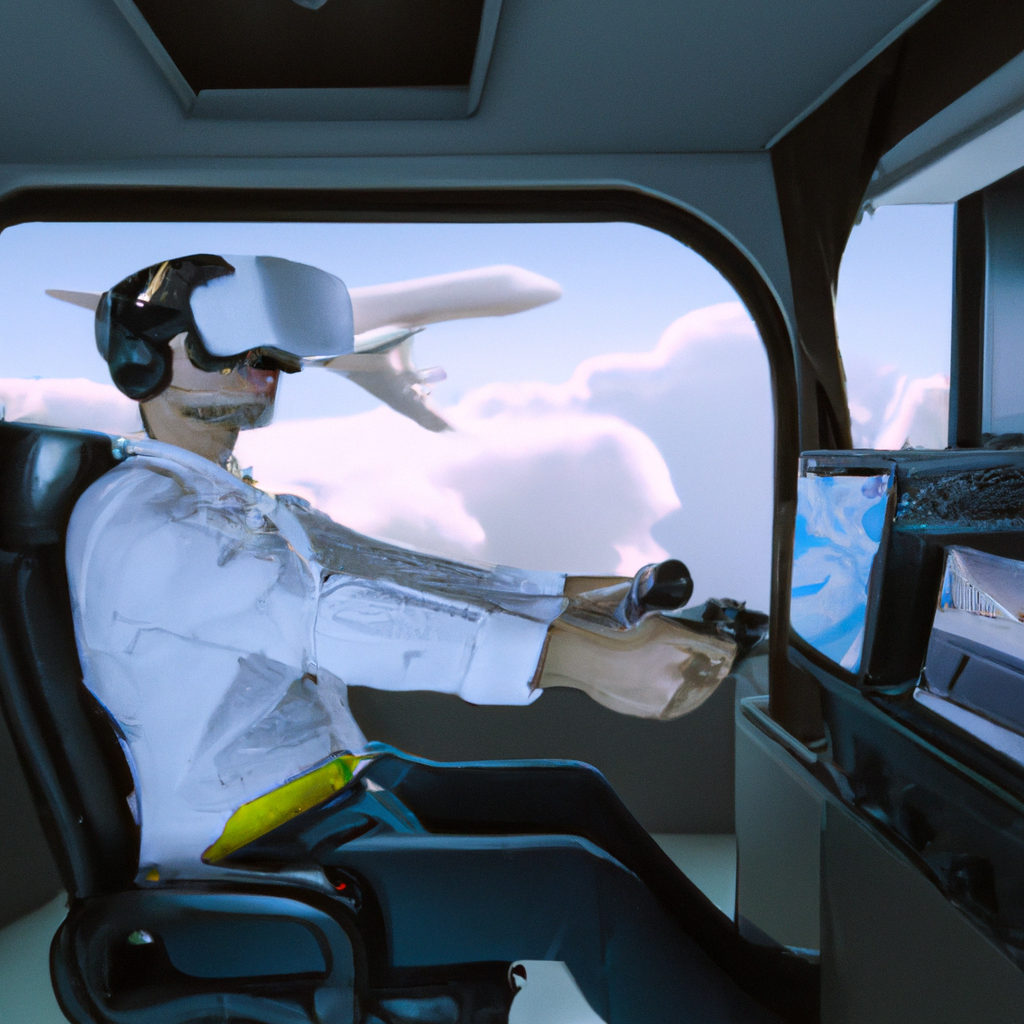작성자 정보
- dml0211 작성
- 작성일
컨텐츠 정보
- 2,342 조회
- 목록
본문

항공 우주 산업의 가상 현실은 다음과 같습니다: 비행 시뮬레이션 및 교육을 개선합니다
가상 현실(VR)은 최근 몇 년 동안 디지털 콘텐츠를 경험하는 방식에 혁명을 일으키며 상당한 발전을 이루었습니다. 특히 항공 우주 산업은 비행 시뮬레이션과 훈련을 개선하기 위해 VR을 활용하여 VR을 채택했습니다. 이 기사에서는 항공 우주 산업에서 VR의 이점과 조종사 교육 방식을 어떻게 변화시키고 있는지 알아보겠습니다.
비행 시뮬레이션 및 훈련에서 VR의 장점입니다
1. 향상된 사실성: VR은 기존의 비행 시뮬레이션으로는 불가능한 수준의 사실성을 제공하는 매우 몰입적인 경험을 제공합니다. 조종사들은 높은 충실도의 시각 및 청각 신호로 이륙에서 착륙까지 현실적인 비행 시나리오를 경험할 수 있습니다. 이것은 그들의 훈련을 향상시키고 그들이 비행의 복잡성을 더 잘 이해하도록 돕습니다.
2. 안전성 향상: VR 시뮬레이션을 통해 조종사는 안전한 환경에서 비상 절차를 연습할 수 있습니다. 이것은 사고의 위험을 줄이고 조종사들이 실제 상황에 대비할 수 있도록 도와줍니다.
3. 비용 효율적: VR 교육은 종종 기존 교육 방법보다 비용 효율적입니다. VR을 사용하면 값비싼 항공기와 체력 훈련 장비가 필요 없습니다.
4. 사용자 정의 가능한 교육: VR 시뮬레이션은 개별 조종사, 항공사 또는 군사 조직의 특정 요구를 충족하도록 사용자 정의할 수 있습니다. 이를 통해 보다 개인화된 교육 경험을 제공하고 조종사가 보다 효율적으로 기술을 개발할 수 있습니다.
5. 유연성 향상: VR 교육은 언제 어디서나 진행할 수 있어 기존 교육 방식보다 편리하고 유연합니다. 이것은 조종사와 항공사 모두에게 이익이 되는 더 빠르고 효율적인 훈련을 가능하게 합니다.

한국의 경우입니다:
한국에서는 비행 시뮬레이션과 훈련을 개선하기 위해 항공 우주 산업에서 가상 현실을 활용하고 있습니다. 한국의 가장 큰 항공사인 대한항공은 조종사들의 훈련을 강화하기 위해 VR 기술을 채택했습니다. 그 항공사는 조종사들에게 매우 사실적인 비행 경험을 제공하는 VR 기반 비행 시뮬레이터를 개발했습니다. 이 기술은 대한항공이 조종사들에게 더 효과적인 훈련을 제공하고 사고의 위험을 줄일 수 있게 해줍니다.
결론은 다음과 같습니다:
가상 현실은 조종사 훈련 방식을 변화시켜 기존의 비행 시뮬레이션으로는 불가능한 수준의 현실감을 제공하는 매우 몰입적인 경험을 제공하고 있습니다. 항공 우주 산업에서 VR의 이점은 안전성 및 비용 효율성 향상에서 유연성과 맞춤형 교육에 이르기까지 다양합니다. 기술이 계속 발전함에 따라, VR은 앞으로 비행 시뮬레이션과 훈련에서 훨씬 더 큰 역할을 할 것입니다.
항공 우주 산업의 가상 현실은 다음과 같습니다: 비행 시뮬레이션 및 교육을 개선합니다

항공 우주 산업에서 가상 현실(VR)의 사용은 최근 몇 년 동안 빠르게 증가하고 있습니다. 이는 비행 시뮬레이션 및 훈련 개선 측면에서 VR이 제공하는 많은 이점 때문입니다. 향상된 사실성에서 향상된 안전성, 비용 효율성 및 향상된 유연성에 이르기까지 VR은 조종사 교육 방식에 혁명을 일으키고 있습니다.
비행 시뮬레이션에서 VR의 주요 이점 중 하나는 기존의 비행 시뮬레이션으로는 불가능한 수준의 현실감을 제공하는 매우 몰입적인 경험을 제공한다는 것입니다. 조종사들은 높은 충실도의 시각 및 청각 신호로 이륙에서 착륙까지 현실적인 비행 시나리오를 경험할 수 있습니다. 이것은 그들의 훈련을 향상시키고 그들이 비행의 복잡성을 더 잘 이해하도록 돕습니다.
비행 훈련에서 VR의 또 다른 이점은 안전성 향상입니다. VR 시뮬레이션을 통해 조종사는 안전한 환경에서 비상 절차를 연습할 수 있습니다. 이것은 사고의 위험을 줄이고 조종사들이 실제 상황에 대비할 수 있도록 도와줍니다. 또한 VR 교육은 종종 기존 교육 방법보다 비용 효율적입니다. VR을 사용하면 값비싼 항공기와 체력 훈련 장비가 필요 없습니다.

VR 교육은 또한 개별 조종사, 항공사 또는 군사 조직의 특정 요구를 충족하도록 사용자 지정할 수 있습니다. 이를 통해 보다 개인화된 교육 경험을 제공하고 조종사가 보다 효율적으로 기술을 개발할 수 있습니다. 또한 VR 교육은 언제 어디서나 진행할 수 있어 기존 교육 방식보다 편리하고 유연합니다. 이것은 조종사와 항공사 모두에게 이익이 되는 더 빠르고 효율적인 훈련을 가능하게 합니다.
한국에서는 비행 시뮬레이션과 훈련을 개선하기 위해 항공 우주 산업에서 가상 현실을 활용하고 있습니다. 한국의 가장 큰 항공사인 대한항공은 조종사들의 훈련을 강화하기 위해 VR 기술을 채택했습니다. 그 항공사는 조종사들에게 매우 사실적인 비행 경험을 제공하는 VR 기반 비행 시뮬레이터를 개발했습니다. 이 기술은 대한항공이 조종사들에게 더 효과적인 훈련을 제공하고 사고의 위험을 줄일 수 있게 해줍니다.
결론적으로, 가상 현실은 항공 우주 산업에서 조종사들이 훈련 받는 방식을 바꾸고 있습니다. 현실감을 높여줍니다
Virtual Reality in the Aerospace Industry: Improving Flight Simulation and Training
Virtual Reality (VR) has made significant strides in recent years, revolutionizing the way we experience digital content. The aerospace industry, in particular, has embraced VR, utilizing it to improve flight simulation and training. In this article, we'll explore the benefits of VR in the aerospace industry and how it is changing the way pilots are trained.
Advantages of VR in Flight Simulation and Training
1. Enhanced Realism: VR provides a highly immersive experience that offers a level of realism not possible with traditional flight simulation. Pilots can experience realistic flight scenarios, from take-off to landing, with high-fidelity visual and auditory cues. This enhances their training and helps them better understand the complexities of flight.
2. Increased Safety: VR simulations allow pilots to practice emergency procedures in a safe environment. This helps to reduce the risk of accidents and prepares pilots for real-life situations.
3. Cost-effective: VR training is often more cost-effective than traditional training methods. The use of VR eliminates the need for expensive aircraft and physical training equipment.
4. Customizable Training: VR simulations can be customized to meet the specific needs of individual pilots, airlines, or military organizations. This allows for a more personalized training experience and helps pilots develop their skills more efficiently.
5. Greater Flexibility: VR training can be conducted at any time and in any location, making it more convenient and flexible than traditional training methods. This allows for faster and more efficient training, which benefits both pilots and airlines.
Case in Korea:
In Korea, virtual reality is being utilized in the aerospace industry to improve flight simulation and training. Korean Air, the country's largest airline, has adopted VR technology to enhance the training of its pilots. The airline has developed a VR-based flight simulator that provides pilots with a highly realistic flight experience. This technology allows Korean Air to provide its pilots with more effective training and to reduce the risk of accidents.
Conclusion:
Virtual reality is changing the way pilots are trained, providing a highly immersive experience that offers a level of realism not possible with traditional flight simulation. The benefits of VR in the aerospace industry are numerous, from increased safety and cost-effectiveness to greater flexibility and customizable training. As technology continues to evolve, it is likely that VR will play an even greater role in flight simulation and training in the years to come.
Virtual Reality in the Aerospace Industry: Improving Flight Simulation and Training
The use of virtual reality (VR) in the aerospace industry has been rapidly increasing in recent years. This is due to the many benefits VR offers in terms of improving flight simulation and training. From enhanced realism to increased safety, cost-effectiveness, and greater flexibility, VR is revolutionizing the way pilots are trained.
One major advantage of VR in flight simulation is that it provides a highly immersive experience that offers a level of realism not possible with traditional flight simulation. Pilots can experience realistic flight scenarios, from take-off to landing, with high-fidelity visual and auditory cues. This enhances their training and helps them better understand the complexities of flight.
Another benefit of VR in flight training is increased safety. VR simulations allow pilots to practice emergency procedures in a safe environment. This helps to reduce the risk of accidents and prepares pilots for real-life situations. In addition, VR training is often more cost-effective than traditional training methods. The use of VR eliminates the need for expensive aircraft and physical training equipment.
VR training can also be customized to meet the specific needs of individual pilots, airlines, or military organizations. This allows for a more personalized training experience and helps pilots develop their skills more efficiently. Furthermore, VR training can be conducted at any time and in any location, making it more convenient and flexible than traditional training methods. This allows for faster and more efficient training, which benefits both pilots and airlines.
In Korea, virtual reality is being utilized in the aerospace industry to improve flight simulation and training. Korean Air, the country's largest airline, has adopted VR technology to enhance the training of its pilots. The airline has developed a VR-based flight simulator that provides pilots with a highly realistic flight experience. This technology allows Korean Air to provide its pilots with more effective training and to reduce the risk of accidents.
In conclusion, virtual reality is changing the way pilots are trained in the aerospace industry. From increased realism to cost-effectiveness and greater flexibility, VR offers many benefits that traditional training methods cannot match. As technology continues to evolve, it is likely that VR will play an even greater role in flight simulation and training in the future.
Summary:
Virtual reality (VR) is increasingly being utilized in the aerospace industry to improve flight simulation and training. The benefits of VR include enhanced realism, increased safety, cost-effectiveness, customizable training, and greater flexibility. In Korea, VR technology is being used by Korean Air to train its pilots in a highly realistic and effective manner. As technology continues to advance, VR is likely to become even more integral to flight simulation and training in the years to come.







